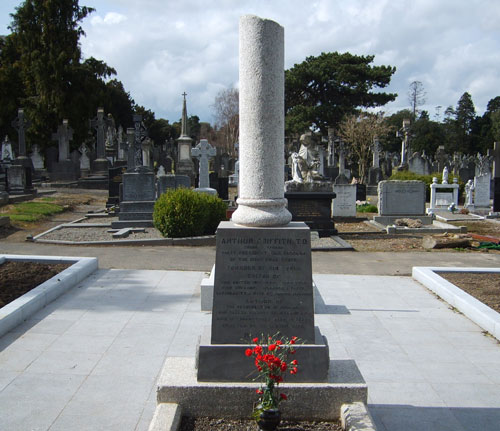A remembrance ceremony, latter marking the centenary of the death of Arthur Griffith, will take place today, at Leinster House.
Arthur Joseph Griffith was born at No.61 Upper Dominick Street, Dublin, on March 31st, 1871, of distant Welsh lineage. His father had been a printer on ‘The Nation‘ newspaper.

Educated by the Irish Christian Brothers, he became the founder of the Sinn Féin party.
In 1916, rebels seized and took over a number of key locations in Dublin, in what became known as the 1916 Easter Rising. After its defeat, it was widely described both by British politicians and the Irish and British media as the “Sinn Féin rebellion”, even though Sinn Féin had very limited involvement. Griffith would be one of those arrested following the Rising, despite not having taken any part in it.
Arthur Griffith later served as Minister for Home Affairs from 1919 to 1921, and Minister for Foreign Affairs from 1921 to 1922.
In September of 1921, Éamon de Valera, the then Irish President, requested Arthur Griffith, to head as Chairman a delegation of Irish diplomats, invested with the full power of independent action, to negotiate on behalf of the Irish people, with the British government, in the setting up of an Irish Republic.
This delegation set up headquarters in Hans Place, London, and following nearly two months of negotiations, on December 5th, Griffith and the other four delegates decided, in private conversation, to sign a Treaty before recommending same to Dáil Eireann.
Griffith was the member of the treaty delegation seen as most supportive of its eventual outcome.
The Treaty was then ratified by the Dáil by 64 votes to 57, on January 7th 1922. Two days later, Éamon de Valera stood down as president and sought re-election by the Dáil, which he lost by a vote of 60 to 58. Mr Griffith then succeeded Mr de Valera as President of Dáil Éireann.
Despite the Treaty being narrowly approved by the Dáil, a political split would lead to the Irish Civil War. Griffith, at the age of 51 years, sadly died suddenly in August 1922, two months after the outbreak of the civil war. He had been about to leave for his office, shortly before 10:00am on August 12th 1922, when he paused to retie a shoelace and fell, slipping into unconsciousness. He did regained consciousness, but collapsed again with blood coming from his mouth. The cause of his death, was identified as cerebral haemorrhage.
His death came, just ten days before the death of Michael Collins, latter who lost his life following an ambush in Co. Cork; seen then as a double tragedy to befall a fledgling independent Irish State.
Arthur Griffith’s body, four days following his death, was interned in Glasnevin Cemetery.
The idiom “Eaten bread is soon forgotten”, was never truer, as was in his case. His widow had to beg his former colleagues for a pension, saying that he ‘had made them all’. She also considered that his grave plot was too modest and threatened to exhume his body.
It took until 1968 before a plaque was finally attached on his former home, situated at St. Lawrence Road, Clontarf, Dublin.

Leave a Reply